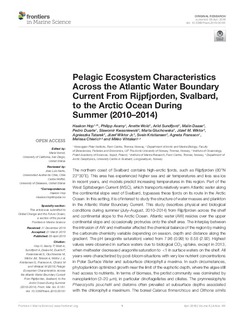| dc.description.abstract | The northern coast of Svalbard contains high-arctic fjords, such as Rijpfjorden (80°N 22°30′E). This area has experienced higher sea and air temperatures and less sea ice in recent years, and models predict increasing temperatures in this region. Part of the West Spitsbergen Current (WSC), which transports relatively warm Atlantic water along the continental slope west of Svalbard, bypasses these fjords on its route in the Arctic Ocean. In this setting, it is of interest to study the structure of water masses and plankton in the Atlantic Water Boundary Current. This study describes physical and biological conditions during summer (July–August, 2010–2014) from Rijpfjorden across the shelf and continental slope to the Arctic Ocean. Atlantic water (AW) resides over the upper continental slope and occasionally protrudes onto the shelf area. The interplay between the intrusion of AW and meltwater affected the chemical balance of the region by making the carbonate chemistry variable depending on season, depth and distance along the gradient. The pH (aragonite saturation) varied from 7.96 (0.99) to 8.58 (2.92). Highest values were observed in surface waters due to biological CO2 uptake, except in 2013, when meltwater decreased aragonite saturation to <1 in surface waters on the shelf. All years were characterized by post-bloom situations with very low nutrient concentrations in Polar Surface Water and subsurface chlorophyll a maxima. In such circumstances, phytoplankton optimized growth near the limit of the euphotic depth, where the algae still had access to nutrients. In terms of biomass, the protist community was dominated by nanoplankton (2–20 μm), in particular dinoflagellates and ciliates. The prymnesiophyte Phaeocystis pouchetii and diatoms often prevailed at subsurface depths associated with the chlorophyll a maximum. The boreal Calanus finmarchicus and Oithona similis dominated AW over the slope and outer shelf, whereas Calanus glacialis and neritic zooplankton (Pseudocalanus, Parasagitta elegans, and meroplankton) dominated cold water masses inside Rijpfjorden. Continued climate warming is expected to increase the contribution of boreal species and pelagic production in the Arctic Ocean. | nb_NO |
